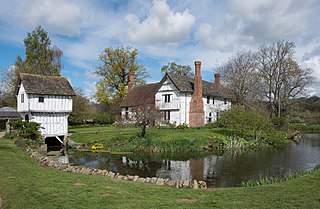Related Research Articles

New Place was William Shakespeare's final place of residence in Stratford-upon-Avon. He died there in 1616. The whole building was demolished by Francis Gastrell, vicar of Frodsham, Cheshire, in 1759. It was never rebuilt and only the foundations remain.

John Hales was a writer, administrator, and member of parliament during the Tudor period.
Sir Robert Catlyn was an English judge and Chief Justice of the Queen's Bench. He should not be confused with his cousin Richard Catlyn, a politician, who died in 1556.

Sir John Lyttelton was an English nobleman, politician, knight, and landowner from the Lyttelton family during the Tudor period.

The Brockhampton Estate is a National Trust property in Herefordshire, England, and is to the north of the A44 Bromyard to Worcester road, opposite the northern edge of Bringsty Common and east from the town of Bromyard.

Sir John St Leger, of Annery in Monkleigh, Devon, was an English landowner who served in local and national government.
Thomas Egerton was a London merchant and member of the Worshipful Company of Mercers.
Sir Hercules Underhill (1581–1658) was the son of William Underhill of Warwickshire, owner of New Place in Stratford-Upon-Avon. William Underhill sold New Place to William Shakespeare in 1597, and Hercules Underhill confirmed the sale in 1602.

Sir William Courtenay was a landowner in Devon and de jure 2nd Earl of Devon. He was the son of George Courtenay and Catherine, daughter of Sir George St Ledger of Annery. He succeeded his grandfather Sir William Courtenay, of Powderham in 1535. He was knighted in 1553 and MP for Plympton in 1555.

Richard Corbet was an English landowner and politician who represented Shropshire in the parliaments of 1558 and 1563.
Sir Thomas White was an English politician.

William Neville of Penwyn and Wyke Sapie, Worcestershire, was the son of Richard Neville, 2nd Baron Latimer, and the author of The Castell of Pleasure. In 1532 he was accused of treason and dabbling in magic.

William Clopton (1538–1592) was a member of the English gentry who inherited New Place in Stratford upon Avon, and in 1563 sold it to William Bott.

William Bayly, Bayley or Bayliffe JP was an English barrister and administrator who briefly served as a Member for the borough of Chippenham in the English Parliament of 1572.

The Mountford family were a gentry family which held lands in Coleshill, Warwickshire, England during the late Middle Ages. They were involved in an inheritance dispute in 1452 which was caused by the disinheritance of a senior line, in favour of the sons of a second wife.
Origins

Sir Thomas Wensley of Wensley in Derbyshire, served five times as a Member of Parliament for Derbyshire, in 1382, 1384, 1386, 1390 and 1394. He was a follower of John of Gaunt, 1st Duke of Lancaster and was killed on 21 July 1403, fighting at the Battle of Shrewsbury for the Lancastrian cause.
Edward Griffin of Dingley, Northamptonshire was an English landowner and lawyer. He was Solicitor General from 1545 to 1552 and Attorney General from 1552 to 1558.
Alexander Unton was an English landowner.

Richard Hough, of Leighton and Thornton Hough, Cheshire was an English landowner and politician. He was elected MP for Cheshire in 1558 under Mary I and after the accession of Elizabeth I was appointed a commissioner of the peace for Cheshire in 1562.
References
- ↑ Stanley Bindoff, The House of Commons, 1509-1558, 2 (London, 1982), p. 573.
- ↑ Stanley Bindoff, The House of Commons, 1509-1558, 2 (London, 1982), p. 573.
- ↑ John Fetherston, Visitation of the County of Warwick in the Year 1619 (London, 1877), p. 69
- ↑ Stanley Bindoff, The House of Commons, 1509-1558, 2 (London, 1982), pp. 573-4.
- ↑ John Hannet, The forest of Arden, its towns, villages, and hamlets (London, 1863), p. 232.
- ↑ Jo Ann Hoeppner Moran Cruz, An Account of an Elizabethan Family (Cambridge, 2018), p. 120: John Fetherston, Visitation of the County of Warwick in the Year 1619 (London, 1877), p. 69
- ↑ Jemma Field, 'A Cipher of A and C set on the one Syde with diamonds: Anna of Denmark’s Jewellery and the Politics of Dynastic Display', Erin Griffey, Sartorial Politics in Early Modern Europe (Amsterdam, 2019), p. 143.